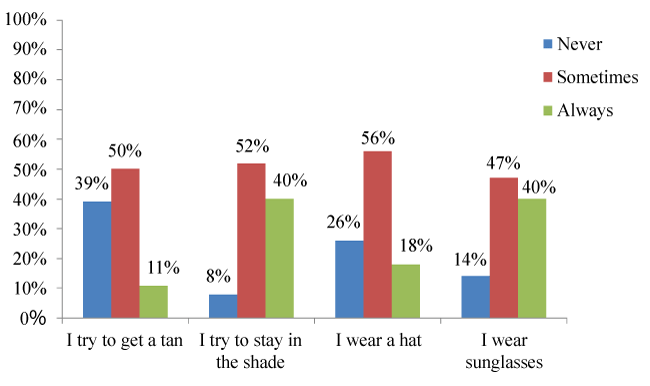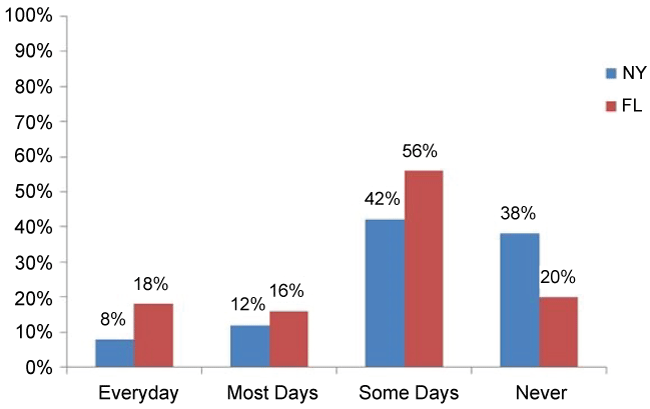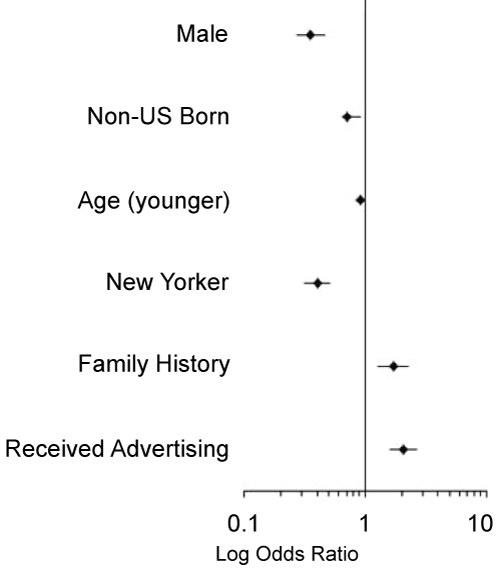Journal of Dermatology Research and Therapy
Knowledge and Behaviors toward the Sun and Skin Cancer: A Study of Hispanics in New York and Florida
Kate V. Viola1*, Kameron S. Rezzadeh2#, Daniel G. Federman3, Christine J. Mathew4, Shasa Hu5, Andrea D. Maderal5, Steven R. Cohen1 and Robert S. Kirsner5
1Albert E. Einstein College of Medicine, Bronx, New York, USA
2UMDNJ-Robert Wood Johnson Medical School, New Jersey, USA
3Yale University School of Medicine, New Haven, Connecticut, USA
4Wesleyan University, Middletown, Connecticut, USA
5University of Miami Leonard M. Miller School of Medicine, Miami, Florida, USA
#Co-First Author
*Corresponding author:
Kate Viola, MD, MHS, Albert Einstein College of Medicine, Division of Dermatology, 3411 Wayne Avenue, Bronx, NY 10467, USA, Tel: 202-415-1705, E-mail: katevviola@gmail.com
J Dermatol Res Ther, JDRT-2-013, (Volume 2, Issue 1), Research Article; ISSN: 2469-5750
Received: December 01, 2015 | Accepted: January 13, 2016 | Published: January 16, 2016
Citation: Viola KV, Rezzadeh KS, Federman DG, Mathew CJ, Hu S, et al. (2016) Knowledge and Behaviors toward the Sun and Skin Cancer: A Study of Hispanics in New York and Florida. J Dermatol Res Ther 2:013. 10.23937/2469-5750/1510013
Copyright: © 2016 Viola KV, et al. This is an open-access article distributed under the terms of the Creative Commons Attribution License, which permits unrestricted use, distribution, and reproduction in any medium, provided the original author and source are credited.
Abstract
Objective: We sought to define knowledge and behaviors on sun protection and skin cancer within the two distinct Hispanic populations of NY and South Florida.
Design: A 50-question survey was developed and distributed to Hispanic patients in New York and Florida medical dermatology, outpatient clinic settings.
Setting: Surveys were distributed through the Department of Dermatology clinics at Albert Einstein College of Medicine/Montefiore Medical Center, Bronx, New York and the University of Miami Hospital, Miami, Florida.
Patients: 1,010 Hispanic patients responded to the survey from both New York and Florida. Surveys were in English and Spanish, as appropriate.
Main Outcome Measures: Variables included patient demographics, sun behavior, sunscreen use, sun exposure, and sunscreen type.
Results: Fifty-four percent (54.5%) of responders were surveyed in New York while 45.5% were surveyed in Miami. The majority of survey participants in both New York and Miami were women (64.1% and 66.2%, respectively). The mean age of all responders was 46.9 years. Over half of all respondents believed olive/brown skin color was resistant to skin cancer (54.1%); nearly one-third thought it was impossible to sunburn on a cloudy day (32.1%). New Yorkers, men, non-US born, and younger responders were less likely to wear sunscreen (all p < 0.001).
Conclusions: Hispanics are not participating in sun protection activities including sunscreen use, particularly those survey participants in New York. Myths and misconceptions regarding the sun and skin cancer are common within this community. Primary and secondary initiatives to prevent and diagnose skin cancers are critical.
Introduction
Over 3 million skin cancers are diagnosed in the United States each year [1,2]. While the incidence of skin cancer is lower in patients of Hispanic descent, a recent report by the Center for Disease Control (CDC) found melanoma incidence rates to be significantly higher in Hispanic women under the age of 50 as compared to Hispanic men; Hispanics had the highest incidence of acral lentigenous melanoma among all races and ethnicities [3]. Additionally, Hispanic patients have the lowest 5- and 10-year melanoma-specific survival rates for acral lentiginous melanoma among all races and ethnicities [4]. The lower rate of survival among melanoma patients of Hispanic descent has been attributed to the presence of more advanced and thicker tumors at diagnosis [5-8]. Factors thought to contribute to substantial delay in diagnosis include inadequate education on melanoma recognition and decreased suspicion for melanoma by healthcare providers when treating patients with darker skin and those higher Fitzpatrick Scale Scores IV-VI [5,9]. Additionally, Hispanic patients are less likely than Caucasians to seek follow-up care for suspicious skin lesions and frequently present with thicker lesions, trends which may be explained by the recent finding that Hispanic patients are less likely than the general population to be aware of free cancer screening programs, in general, available to them [10-13].
Little is known about awareness of skin cancer, perceptions of risk, and use of sun-protection measures within the Hispanic population of the United States. Americans receive the majority of their skin cancer information from multimedia sources which tend to disproportionately target and educate individuals with fair skin and lower Fitzpatrick Scale Score: I-III on the risk factors for skin cancer [14,15]. Physicians frequently neglect to demonstrate the importance of skin self-examinations to non-white patients [14]. Additionally, the lack of multimedia information geared towards non-whites has led to a dearth of knowledge within the Hispanic population on how to detect concerning skin lesions [15].
The knowledge and behaviors of Hispanic patients have become increasingly important to the healthcare system each year as the size of this population continues to grow at a remarkable rate. Between 2000 and 2010, the Hispanic population of the United States increased at four times the rate of the total population overall [16]. Of the 308.7 million people residing in the United States in 2010, 50.5 million (16%) were of Hispanic descent, which is estimated to grow to 25% in the not too distant future. New York and Florida are among the top five states most heavily populated by Hispanic residents [16,17].
Bronx County in New York and Miami-Dade County in Florida are predominantly Hispanic (54% and 65%, respectively) [16]. Therefore, we chose two academic centers in these counties to collect our cohort data. Our rationale for studying the Hispanic population of two different sites is that Bronx County and Miami-Dade County have markedly different profiles of Hispanic origin groups; Puerto Ricans and Dominicans are best represented in Bronx County while Cubans and Colombians are largely concentrated in Miami-Dade County [17]. By surveying responders in two counties with vastly different compositions in terms of the origins of their Hispanic residents, we obtain a more accurate characterization of the knowledge and behaviors of the US Hispanic population at large and possible variations between different cohorts of Hispanic patients.
This study is a knowledge assessment of behaviors towards the sun and skin cancer within the largest communities of Hispanics (Bronx, New York and Miami, Florida) Hispanic population of the United States examining sun exposure, sunscreen use, and sun protection factor (SPF) level. Conclusions drawn from this work have the potential to guide primary and secondary prevention initiatives within the Hispanic population at large.
Methods
Survey design
We developed the questionnaire used in this study from validated surveys and with permission from the Melanoma Foundation and with guidance from authors who published a study of Hispanic high school students in 2007 [18]. Variables included patient demographics, sun behavior, sun protection, sun exposure, and sunscreen level. We tested the survey in both languages on 20 random patients to ensure optimal understanding and clarity for our future survey responders.
Survey distribution and collection
The 50-question survey was distributed to 1,010 Hispanic patients through the Department of Dermatology clinics at Albert Einstein College of Medicine/Montefiore Medical Center, Bronx, New York and the University of Miami Hospital, Miami, Florida. Participants at both sites were asked in the medical dermatology waiting rooms prior to their appointments if they were Hispanic and would like to participate in a survey examining Hispanic peoples' knowledge and behaviors toward the sun and skin cancer. To note, all patients agreed to participate in this survey who identified themselves as Hispanic (100% response rate). Verbal consent was obtained when patients agreed to participate. Participants were surveyed in English and Spanish, as appropriate. Survey review and data compilation was independently performed by two investigators (K.V.V. and C.J.T.).
Statistical analysis
Data were summarized using descriptive characteristics including respondent characteristics, sun behavior and protection, and sunscreen use and SPF level. Bivariate analyses were performed to determine variables associated with sunscreen use, sun exposure, and SPF level. A logistic regression was performed to define association patterns between our independent variables and sunscreen usage. Questions regarding sun protection behaviors (Figure 1) and sun exposure/SPF level (Table 1) were analyzed using total sample size as site differences were non-significant. All statistical analyses were performed with the SAS statistical software package (version 9.2; SAS Institute, Inc).
![]()
Table 1: Survey outcomes: Bivariate analyses of sun exposure and sunscreen use.
View Table 1
Results
Patient characteristics
A total of 1,010 Hispanic persons were surveyed (Table 2). Among responders in this study, 54.4% (550) were surveyed in New York and 45.6% (460) were surveyed in Miami. The age distribution of patients surveyed in both New York and Florida was comparable; both cohorts were predominantly female (64% and 66%, respectively). However, the cohort surveyed in Florida had a higher percentage of patients older than 55 when compared with those in New York (40% and 29%, respectively). Eighteen percent (99) of responders in New York and 28% (129) of responders in Miami acknowledged a family history of skin cancer. Additionally, the majority of patients in New York (286, 52%) cited a specific skin problem as the reason for their visit; 40% (183) of responders from Miami listed a reason other than a skin check (mole), specific skin problem, or cosmetic concern was the reason for their visit. Approximately one-half of all responders were born outside of the United States. Forty-six percent (121) of responders living in New York and 43% (99) of participants in Miami reported moving to the United States (US) 18 to 25 years ago.
![]()
Table 2: Respondent Characteristics (N = 1010).
View Table 2
Sun protection behaviors and exposure
Of the 1,010 patients surveyed in this study, 50% responded "Sometimes" when asked if they expose themselves to sunlight in order to "try to get a tan" (Figure 1). Eight percent of participants report preventing sun exposure by never staying in the shade. Twenty-six percent of survey responders never wear hats while 14% never wear sunglasses.
Thirty-eight percent of responders in New York and 20% of those surveyed in Miami reported never utilizing sunscreen (Figure 2). Conversely, 8% and 18% of responders in New York and Miami, respectively, report sunscreen utilization on a daily basis.
Patients were also surveyed on the habitual frequency and duration of their sun exposure (Table 1). Of all responders, 26% responded that they spend more than two hours in the sun during weekdays; 26% had over two hours of exposure on weekends. The largest proportion of sunscreen users at both survey sites reported applying an SPF of 30+ sunscreen. In our bivariate analysis, the duration of sun exposure and SPF level were associated with sunscreen use (all p < 0.001).
Myths and misconceptions
When asked whether using a hat with a wide brim and sun glasses may prevent eye damage, 81.6% (802) of responders stated that this was true. Fifty-four percent of responders failed to affirm the statement "people with olive or brown skin can get skin cancer." The majority of responders (62.3%) believed that there is a "safe way to get a tan from the sun." One-third of all responders thought that it is not possible to become sunburned on a cloudy day. Our bivariate analysis of myths and misconception variables by location (New York versus Miami) was non-significant.
Odds of sun screen utilization
In our logistic regression, patients were less likely to apply products containing sunscreen if male, non-US born, and/or surveyed in New York (Figure 3). In both states, patients were more likely to use sunscreen if they reported a family history of skin cancer. Additionally, responders who were exposed to product advertising were more likely to wear sunscreen. To note, approximately half of all responders reported having seen advertising for products containing sunscreen; of these, 70% of Floridians and 40% of New Yorkers proceeded to purchase the advertised product.
Discussion
The Hispanic population of the United States continues to grow at a rapid rate. Studies have shown that the incidence of melanoma has increased within this population while skin cancer survival has not improved in Hispanics to the same extent as in Caucasians [18,19]. The presence of advanced lesions as well as increased incidence in Hispanic patients suggests that primary and secondary prevention efforts, such as regular skin examinations, are not occurring at an optimal rate within this population [18,20].
Our study demonstrates that Hispanics are not optimally participating in sun protection activities, including the use of sunscreen, particularly in New York. We found that among those Hispanics surveyed, sunscreen use occurred more frequently in Florida. Whether this is due to the increased ambient sun exposure with year-round sun exposure in Miami-Dade County, the higher UV index as compared to New York or other factors is not known. However, it should be noted that even among Floridians, one in every five responders reported never using sunscreen. Even more alarming, 38% of Hispanics in New York never use sunscreen products. These findings can be attributed, in part, to the protective value of skin color Fitzpatrick Scale Score (IV-VI) against sun-induced malignancy. Interestingly, responders were less likely to apply sunscreen if they were non US-born, men, younger, or living in New York and should be considered as high-risk sub-populations within our cohort. Acculturation may play a key role in sun protective behaviors among Hispanics as non-US born Hispanics residing in the US were less likely to wear sunscreen as compared to those born in the US [21]. It is also important to note that the majority of sun protective behaviors were only "sometimes" performed as demonstrated in figure 1 by all survey participants.
Sunscreen use can prevent acquired nevi, actinic keratosis, squamous cell carcinoma and melanoma [22-24]. A considerable number of responders who reported exposure to sunscreen advertisements proceeded to purchase the advertised product. This suggests that ad campaigns are highly effective tools in generating public awareness for sun protection. Unfortunately, current advertisements often target individuals with fair skin, blonde hair, or red hair [14]. The lack of advertising and public awareness campaigns tailored to Hispanic audiences is also responsible for the prevalence of sun exposure myths and misconceptions within this population. Hispanic patients today are less likely than other races to learn about proper skin self-examination and sun protection from both dermatologists and the media despite presenting with advanced cancers and increased mortality.
Limitations
Limitations include setting and gender bias. This survey was completed and submitted by patients in dermatology waiting rooms; responders in this setting are more likely to be concerned with the appearance and health of their skin than the general population. The majority of responders were female which likely led to a gender bias in our results. In addition, we do not differentiate between nationalities of origin or variation of Fitzpatrick Scale Scores of survey participants within the two Hispanic populations studied; this fails to appreciate potential nuances in sun-protective behavior between responders from different countries and with different phototypes. To note, Bronx County has the highest reported population of Dominicans and Puerto Ricans in the US who are defined as Hispanic, although Puerto Rico is a commonwealth of the United States [17]. Miami- Dade County has the greatest proportion of Hispanics in the US from Cuba, Columbia, Honduras, and Peru [17].
Conclusions
Our survey demonstrates that myths and misconceptions regarding sun protection and skin cancer are prevalent within Hispanic populations in New York and Florida. Given that this survey was conducted in dermatology waiting rooms with the majority of respondents having seen the health care provider previously, we can also conclude that dermatologists are frequently neglecting to instruct their Hispanic patients on the importance of sun protection and the dangers of skin cancer. Primary prevention including public awareness campaigns and targeted advertising for sunscreen products may be effective tools to improve awareness and sun-protective behaviors within the Hispanic community.
Implications
Education on the dangers of sun exposure is essential to the prevention of skin cancer within the Hispanic population. Novel primary and secondary prevention strategies are vital to the early detection of sun-induced malignancy within this population.
References
-
Rogers HW, Weinstock MA, Harris AR, Hinckley MR, Feldman SR, et al. (2010) Incidence estimate of nonmelanoma skin cancer in the United States, 2006. Arch Dermatol 146: 283-287.
-
http://www.cancer.gov/cancerinfo/types/Skin
-
Wu XC, Eide MJ, King J, Saraiya M, Huang Y, et al. (2011) Racial and ethnic variations in incidence and survival of cutaneous melanoma in the United States, 1999-2006. J Am Acad Dermatol 65: S26-37.
-
Bradford PT, Goldstein AM, McMaster ML, Tucker MA (2009) Acral lentiginous melanoma: incidence and survival patterns in the United States, 1986-2005. Arch Dermatol 145: 427-434.
-
Cormier JN, Xing Y, Ding M, Lee JE, Mansfield PF, et al. (2006) Ethnic differences among patients with cutaneous melanoma. Arch Intern Med 166: 1907-1914.
-
Byrd-Miles K, Toombs EL, Peck GL (2007) Skin cancer in individuals of African, Asian, Latin-American, and American-Indian descent: differences in incidence, clinical presentation, and survival compared to Caucasians. J Drugs Dermatol 6: 10-6.
-
Balch CM, Soong SJ, Gershenwald JE, Thompson JF, Reintgen DS, et al. (2001) Prognostic factors analysis of 17,600 melanoma patients: validation of the American Joint Committee on Cancer melanoma staging system. J Clin Oncol 19: 3622-3634.
-
Kabigting FD, Nelson FP, Kauffman CL, Popoveniuc G, Dasanu CA, et al. (2009) Malignant melanoma in African-Americans. Dermatol Online J 15: 3.
-
Black WC, Goldhahn RT Jr, Wiggins C (1987) Melanoma within a southwestern Hispanic population. Arch Dermatol 123: 1331-1334.
-
Friedman LC, Bruce S, Weinberg AD, Cooper HP, Yen AH, et al. (1994) Early detection of skin cancer: racial/ethnic differences in behaviors and attitudes. J Cancer Educ 9: 105-110.
-
Vega WA, Rodriguez MA, Gruskin E (2009) Health disparities in the Latino population. Epidemiol Rev 31: 99-112.
-
Sussner KM, Thompson HS, Valdimarsdottir HB, Redd WH, Jandorf L (2009) Acculturation and familiarity with, attitudes towards and beliefs about genetic testing for cancer risk within Latinas in East Harlem, New York City. J Genet Couns 18: 60-71.
-
Pipitone M, Robinson JK, Camara C, Chittineni B, Fisher SG (2002) Skin cancer awareness in suburban employees: a Hispanic perspective. J Am Acad Dermatol 47: 118-123.
-
Robinson JK, Rigel DS, Amonette RA (1997) Trends in sun exposure knowledge, attitudes, and behaviors: 1986 to 1996. J Am Acad Dermatol 37: 179-186.
-
Hu S1, Soza-Vento RM, Parker DF, Kirsner RS (2006) Comparison of stage at diagnosis of melanoma among Hispanic, black, and white patients in Miami-Dade County, Florida. Arch Dermatol 142: 704-708.
-
Enis SR, Rios-Vargas M, Albert NG (2010) The Hispanic Population: 2010. 2010 Census Briefs, U.S. Department of Commerce, Economics and Statistics Administration.
-
Motel S, Patten E (2012) The 10 largest Hispanic origin groups: characteristics, rankings, top counties. Pew Research Center, Washington.
-
Ma F, Collado-Mesa F, Hu S, Kirsner R (2007) Skin cancer awareness and sun protection behaviors in white Hispanic and white non-Hispanic high school students in Miami, Florida. Arch Dermatol 143: 983-988.
-
Ries L, Eisner M, Kosary C, Hankey B, Miller B, et al. (2005) SEER Cancer Statistics Review, 1975-2002. National Cancer Institute, Bethesda, MD.
-
Weiss J, Kirsner RS, Hu S (2012) Trends in primary skin cancer prevention among US Hispanics: a systematic review. J Drugs Derm 11: 580-586.
-
Andreeva VA, Unger JB, Yaroch AL, Cockburn MG, Baezconde-Garbanati L, et al. (2009) Acculturation and sun-safe behaviors among US Latinos: findings from the 2005 Health Information National Trends Survey. Am J Public Health 99: 734-741.
-
Hall HI, Jones SE, Saraiya M (2001) Prevalence and correlates of sunscreen use among US high school students. J Sch Health 71: 453-457.
-
Green A, Williams G, Neale R, Hart V, Leslie D, et al. (1999) Daily sunscreen application and betacarotene supplementation in prevention of basal-cell and squamous cell carcinomas of the skin: a randomized controlled trial. Lancet 354: 723-729.
-
Green AC, Williams GM, Logan V, Strutton GM (2011) Reduced melanoma after regular sunscreen use: randomized trial follow-up. J Clin Oncol 29: 257-263.








